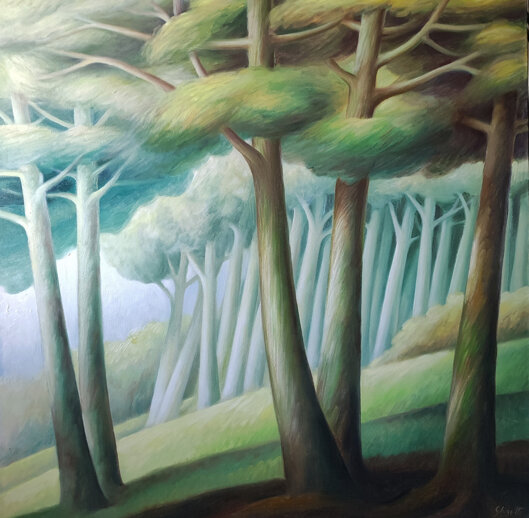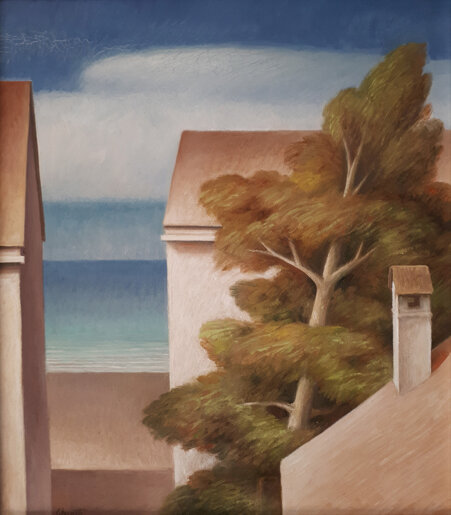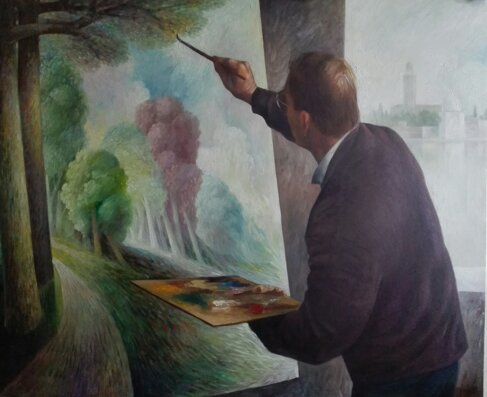Social
Contattaci
Indirizzo
Fondamenta Cristoforo Parmense 10 Murano VE
30141
L'arte di Giampaolo Ghisetti
L'amore per l'Arte
Last Supperolio su tela 190x390
Giampaolo Ghisetti nasce a Venezia nel 1944, autodidatta, si avvicina alla pittura verso la metà degli anni cinquanta. Negli anni sessanta partecipa a varie collettive acquisendo segnalazioni e premi. In quel periodo si trasferisce a Murano e inizia l'attività di decoratore su vetro. La fama della sua abilità gli vale commissioni da tutto il mondo e lo porta ad eseguire ritratti delle più rilevanti personalità della cultura, dello spettacolo e della politica. Contemporaneamente Ghisetti si dedica assiduamente alla sua arte primaria, la pittura. Nel 1970 viene premiato con diploma di medaglia d'oro dall'Accademia di S. Andrea in Roma. Sue opere si trovano incollezioni italiane e straniere. Vive e lavora a Murano-Venezia

War



Venezia
Notturno ai Miracoli
La chiesa dei Miracoli
Giampaolo Ghisetti was born in Venice in 1944, self-taught, he approached painting in the mid-1950s. In the sixties he took part in various group exhibitions, receiving mentions and prizes. In that period he moved to Murano and began working as a glass decorator. The fame of his skill earned him commissions from all over the world and led him to paint portraits of the most important personalities in culture, entertainment and politics. At the same time, Ghisetti assiduously dedicated himself to his primary art, painting. In 1970 he was awarded a gold medal diploma by the Accademia di S. Andrea in Rome. His works can be found in Italian and foreign collections. He lives and works in Murano-Venice

Case in collina
C’è una stagione dello spirito in cui le passioni s’acquietano, l’aria diventa tersa e tutto, nell’esperienza dell’uomo, sembra assumere una nuova armonia. E’ il momento aurorale dell’esistenza,in cui gli occhi scoprono il mondo col ritrovato candore dei sentimenti. E’ qui, in questo eden ideale, che s’è fermata la pittura di Giampaolo Ghisetti. Qui essa ha assunto toni chiari e luminosi, s’è depurata da ogni fastidioso particolarismo, ha mirato all’essenzialità delle forme. S’è fatta estatico incantamento.
Ghisetti è un pittore veneziano da molti anni residente ai margini di un’isola come Murano, a contatto diretto con la laguna. Ha sempre dipinto. Come gli antichi artigiani muranesi s’è cimentato nella decorazione del vetro con smalti a fuoco; ha eseguito copie e variazioni di copie di quadri cinquecenteschi e seicenteschi. Il suo tirocinio è stato lungo e meticoloso, attento ad apprendere anche i piccoli particolari (i trucchi) del mestiere. Ha raggiunto così, gradualmente ma con estrema coscienza professionale, una maturità artistica.
Il suo sguardo s’è volto, col tempo, ad una decantazione dell’oggetto, cioè ad una purificazione. Tutto ha cominciato ad obbedire ad un ritmo pacato delle cose: ad una musica interiore. Gli esempi erano lontani: il quattrocento toscano, soprattutto con Piero della Francesca e con l’Angelico; la pittura fiamminga nella versione più puristica (quindi Vermeer); in un’ottica più ravvicinata, i nostri anni Venti, con le lezioni di Carrà e Morandi. Più che derivazioni stilistiche, s’è trattato di assonanze spirituali: un clima, appunto, di ritrovata serenità dell’anima.

Paesaggio Lagunare



Sentiero montano
Paesaggio primaverile
Alberi in pianura
Ecco quindi la sua interpretazione del mondo. Essa nasce inizialmente da una meditazione un approfondimento, mirando anche e soprattutto alle distese immote della laguna attorno a Murano. Il paesaggio s’è impresso all’interno, saldandosi con le suggestioni della storia dell’arte. Gli scorci lagunari, con l’acqua cilestrina e le piccole case sul fondo, hanno assunto una dimensione d’incanto, di lungo silenzio: le forme si sono armonizzate, i colori hanno cominciato a “ cantare “ totalmente.
L’occhio dalla finestra di casa s’è spinto lontano, verso la distesa della laguna; poi, magari, è tornato sugli oggetti familiari, le piccole nature morte di stoviglie e frutta sul tavolo; e, ancora, ha ricreato alberi e case tra natura e fantasia. Negli spazi rarefatti si sono adagiati nudi pudichi ed armoniosi; altre figure femminili sono apparse su spiagge deserte tra ombrelloni colorati. Hanno fatto irruzione le maschere del Carnevale veneziano; e i volti ilari si son fatti d’un colpo severi, persino dolorosi, in una assorta Deposizione … Un quadro dopo l’altro: una galleria di angolazioni del mondo, ma un unico sentimento che le unisce. Luci smorzate con dolcezza; Mezzi toni sapientemente accostati; geometrie semplici in perfetto accordo. Pittura come musica.
Lui, Ghisetti, non parla molto. Dice : “ L’immagine ho bisogno di filtrarla” . Il suo è un lungo e paziente approccio ad una misura aurea delle cose. Ha imparato a semplificare senza mai banalizzare; ha persino adoperato le scomposizioni cubistiche per arrivare ad una sintesi non gratuita, bensì rispondente ad una forma intellettuale. Niente impressionismo, quindi; e neppure un cenno di deformazione espressionistica.
Un velo di chiarori diffusi vibra appena nell’aria: le stesure sono nette, fino al limite di una bidimensionalità entro cui la prospettiva si forma secondo la grande regola rinascimentale; e l’aria e la luce si percepiscono nello spazio assorto. Anche laddove (come nelle composizioni con figure) le linee assumono un movimento serrato, tutto si svolge secondo armoniche strutture, con ritmi che traspaiono sempre nell’orchestrazione del comporre.
Un filtro, appunto, guida la mano del pittore. Nulla viene a disturbare questo sforzo della mente di raggiungere una serenità che non è soltanto estetica: riflette un modo di vivere.
Siamo ben lontani dalle nevrosi e dalle sofisticazioni del nostro tempo; ma siamo vicini a quell’approdo cui la pittura d’oggi tende, come una insopprimibile necessità interiore.
Paolo Rizzi 1993

la poltrona rossa


Paesaggio Veneto
Murano verso sera

L'oggi
Here he has taken clear and luminous tones, cleansed from every annoying detail, he aimed at the essence of forms. It become an ecstatic enchantment.
Ghisetti is a Venetian painter, for many years residing on the edge of an island like Murano, in direct contact with the lagoon. He has always painted. Like the ancient Murano artisans, he has been used paintings in glass decoration with enamels and he has made copies and variations of copies of sixteenth and sevententh century paintings.
His internship was long and meticulous, also attentive to learning the little details (tricks) of the craft, he achieved this artistic maturity gradually but with an extreme professional conscience.
His glance, over time, faced a decantation of the object, that is, a purification. Everything began to obey a peaceful pace of things an inner music.
The examples were far away: the 14th century Tuscan( especially with Piero della Francesca and Beato Angelico) , Flemish painting in the most purist version, then Vermeer and most recentely the lessons of Carrà and Morandi.
More than stylistic derivations, it has been about spiritual assonances: a climate, in fact, of the regained serenity of the soul.
There is a season of spirit in which passions smell, the air becomes full and everything, in the experience of man, seems to take on a new harmony. It is the auroral moment of existence, in which the eyes discover the world and regain the candor of feelings. It is here, in this ideal, that the painting of Giampaolo Ghisetti has stopped.

Il giorno, la notte

Ragazza con colomba
Here is his interpretation of the world. It originates from a meditation, from a continuous deepening, aiming, and above all, to the immense stretches of the lagoon around Murano. The landscape has embellished inside, with the suggestions of the history of art. The lagoon views, with cylinder water and small houses on the bottom, have taken on a dimension of charm, long silence: the shapes have harmonized, the colors began to "sing" altogether.
The eye from the window of the house pushed far away to the expanse of the lagoon; then, perhaps, it is back on the familiar objects, the small dead nature of tableware and fruit; and yet, it has recreated trees and houses between nature and fantasy. Naked and harmonious bare feet lay in the rare spaces; other female figures have appeared on deserted beaches among colored umbrellas.
They recall the masks of the Venetian Carnival; in which the lyrical faces have been made of a severe, even painful stroke, in an absorbed “Deposition” ... One picture after another: a gallery of angles of the world, but a unique feeling that unites them. Light dimmed with sweetness; words cleverly approached; simple geometries in perfect agreement. Painting as music.
He, Ghisetti, does not speak much. She says, "I need to filter the image." His is a long and patient approach to a golden measure of things. He has learned to simplify without ever trivializing; he even used cubistic decompositions to get a free synthesis, but responding to an intellectual form. No impressionism, therefore; nor even a nod of expressionist deformation.
A veil of diffused lightening vibrates just in the air: the shapes are net, to the limit of a two-dimensionality within which the perspective is formed according to the great Renaissance rule; and the air and light are perceived in the absorbed space. Even where (as in compositions with figures) the lines assume a tight movement, everything is done according to harmonic structures, with rhythms that always transpire in the orchestration of the composite.
A filter, in fact, guides the painter's hand. Nothing gets distracted by this effort of the mind to achieve serenity that is not just aesthetic: it reflects a way of life.
We are far from the neuroses and sophistications of our time; but we are close to that approach which today's painting leans towards as an inexpressible inner necessity.
Paolo Rizzi 1993

Nel Bosco



Paesaggio lagunare
Borgo collinare
Paesaggio Veneto


La basilica di San Donato a Murano
Case verso il fiume

Alla chitarraolio su tela cm.60x60


Alberi
Dalla collina

Dalla finestra


Orizzonte
Pianura

Giocando nell'acqua

Frutta con paesaggio



Canale veneziano
Immaginando Venezia
Paese Lagunare

Al lavoro


In Barena
Sul fiume, verso sera
Social
Contattaci
Indirizzo
Fondamenta Cristoforo Parmense 10 Murano VE
30141

